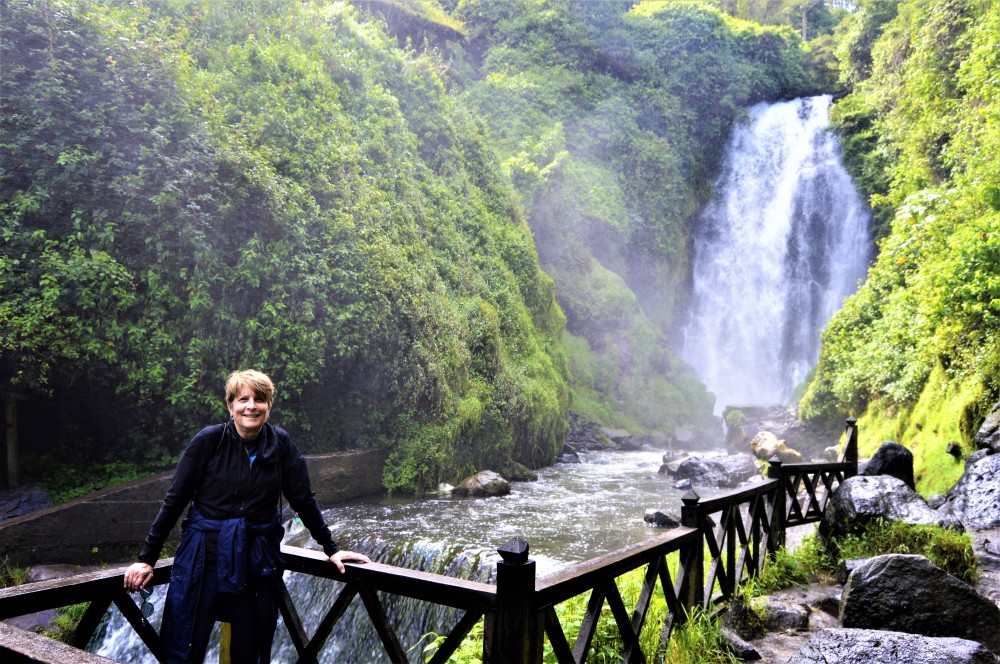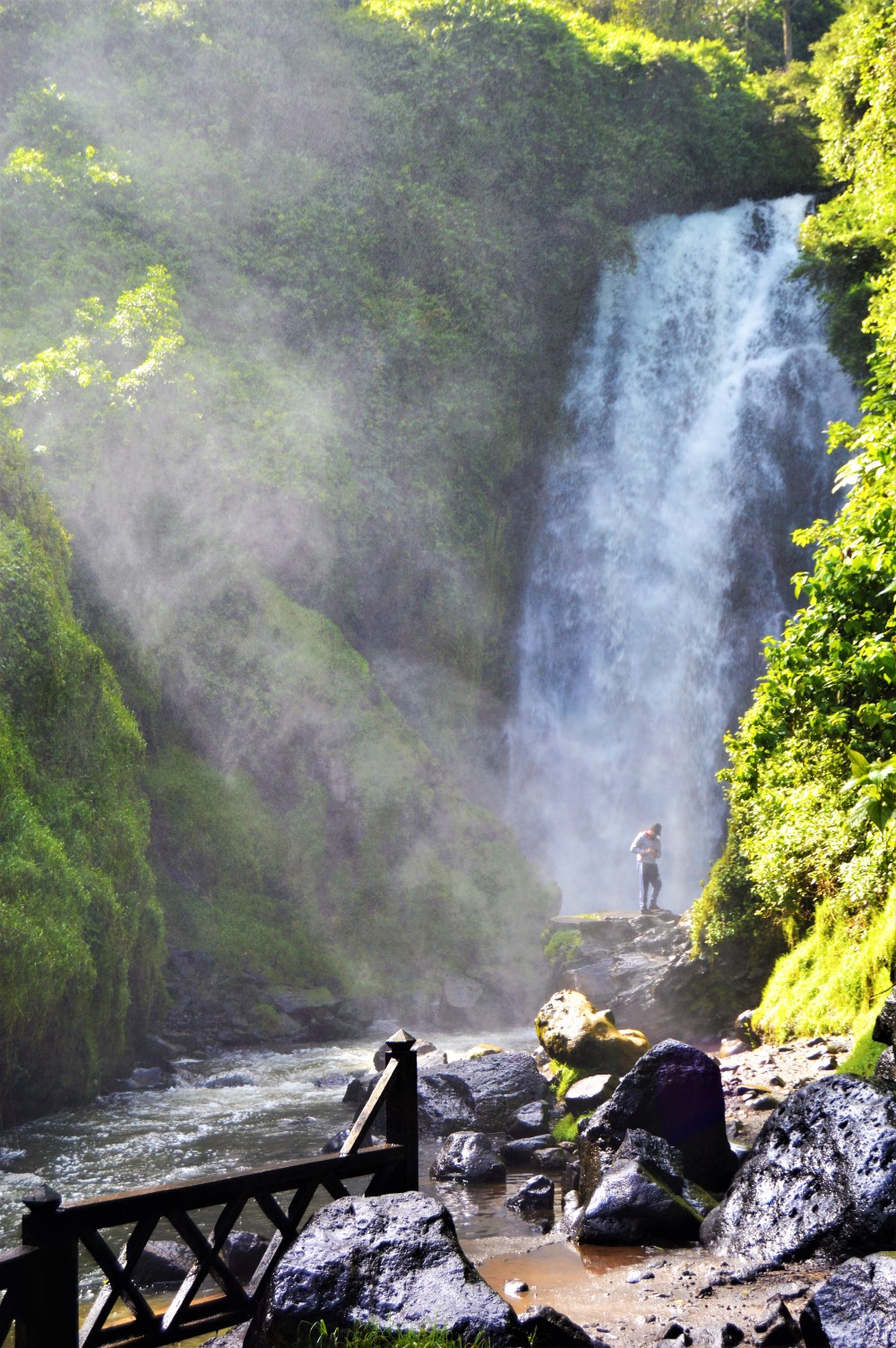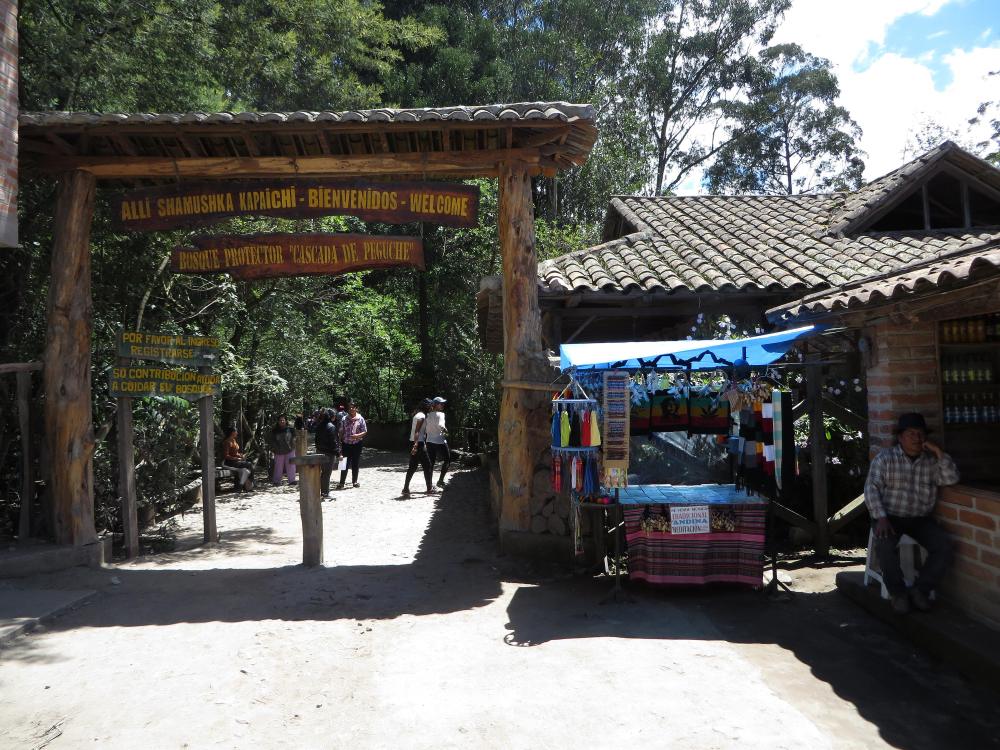Birth of a Living Museum
Walking into the Museo Viviente Otavalango in Otavalo, I heard voices.
We had not been greeted and there was no one there. But the voices of workers who once toiled in what was the San Pedro textile factory were loud and clear. The past emanated from the corners of the silent rooms. Footsteps of artisans hurrying to work made the old wooden floors creak once again, echoing my own.
My friend and I found the Museo by accident. Quite literally. We had been looking for it, but the “ten minute walk” promised by the tourist office in town had turned into 30 and it was nowhere in sight. On Google maps, the museo is on “Unnamed Street.” Big help. We found a friendly local woman who offered to lead us. Then we bumped into a man and young boy who pointed us in the opposite direction.
Finally, we found it. Another couple was just getting into a taxi when we arrived, leaving us the only visitors on the property.
What a property. The 200-year-old shell of the former textile factory still stands. Only one of the three large buildings is still empty. Woven between them are tiny homes of some of those who have vowed to preserve the ancient culture of the Quechua.

 We were soon met by José René Zambrano Cachimuel, the president of The Otavalango Living Museum. As a young man, René worked in the same the buildings now housing the museum. It is because of René, and his determined wife Luzmila, that the dilapidated factory has been preserved, and the museum created.
We were soon met by José René Zambrano Cachimuel, the president of The Otavalango Living Museum. As a young man, René worked in the same the buildings now housing the museum. It is because of René, and his determined wife Luzmila, that the dilapidated factory has been preserved, and the museum created.
Years after working there, curiosity took him back to the factory where he found it in ruins. There was very little left, and most of the furniture and antique looms had been stolen. René began the several years’ process of rallying support for an indigenous center. He ever coerced his wife into writing the president of Ecuador to ask for his support. That letter led to the president soliciting a bank to loan funds to the project.
In 2011, a company of twenty Quechuas, also known as Kichwas for their language, from Otavalo became the first indigenous owners of La Fabrica San Pedro. Together they fed the dream promoted by René and Luzmila, joining to find and preserve artifacts and ancient stories.
The Otavalango Living Museum is an interactive classroom, showcasing traditional games, dances, and ancestral tales. Groups schedule meetings in the renovated classroom and teachers offer regular classes in the Kichwa language.
 My friend, Carol, and I were a captive audience. We marveled at the talents of seamstresses who create elaborate costumes. René explained the traditional Otavalan clothing that began with two versions before the Spaniards arrived and two more after they occupied the land.
My friend, Carol, and I were a captive audience. We marveled at the talents of seamstresses who create elaborate costumes. René explained the traditional Otavalan clothing that began with two versions before the Spaniards arrived and two more after they occupied the land.
We learned about ceremonial weddings during which the couple remains on their knees. They are blessed by herbs and antique artifacts, and the event ends with the woman braiding the man’s long, black hair.
There are masks and traditional costumes used for celebrations blessing the sun, moon and earth. René playfully dons one mask and takes a few steps, leaving us all laughing.
We hover over the display of Kichwa burials. We are enthralled with the tiny casket surrounded by toys. It’s part of the Incan culture passed down that encourages those left behind to populate the burial ground of loved ones with the things they will need in the next life.
 René does his best to make the displays come alive. There is another man in the weaving room, who begins spinning yarn as we enter. It isn’t enough for our tour guide who drops to the ground to operate a back strap weaving loom.
René does his best to make the displays come alive. There is another man in the weaving room, who begins spinning yarn as we enter. It isn’t enough for our tour guide who drops to the ground to operate a back strap weaving loom.
Our private tour ends and our senses are full. We are so thankful we chose the museum as our last stop in Otavalo. René’s passion is infectious; he found converts in both of us.
Museo Viviente Otavalango is open Monday through Saturday from 9 a.m. to 5 p.m. It’s important to call ahead at (593)062.903.879, especially if you come with a group, to ensure an English-speaking guide. Advance notice also gives René an opportunity to gather members of the community to set up live demonstrations.
Admission is just $5. The official address is Vía Antigua a Quiroga #1230. But just ask for the Antigua Fábrica San Pedro. The Museo Viviente Otavalo hasn’t quite stuck – yet.
ContactMuseo Viviente Otavalango at museovivienteotavalango@hotmail.com or http://www.otavalango.org










 I chose the path that got us lost.
I chose the path that got us lost.

 Peguche is one of many waterfalls throughout Ecuador. But it holds three distinctions: It’s found inside one of the most beautiful forests of northern Ecuador, it’s easily accessed from the main road through Otavalo, and it’s an indigenous ceremonial site.
Peguche is one of many waterfalls throughout Ecuador. But it holds three distinctions: It’s found inside one of the most beautiful forests of northern Ecuador, it’s easily accessed from the main road through Otavalo, and it’s an indigenous ceremonial site.






 In 1963 I was scarred for life.
In 1963 I was scarred for life. From that day forward, I had no interest in being anywhere near a bird.
From that day forward, I had no interest in being anywhere near a bird.





 In the canyon above Susudel, Aguirre tells us, the first condor known to have been born in the area was named Arturo. Shot when he was just a few years old, he is memorialized by a beautiful sculpture in the center of town. The artist, architect Fausto Cardoso Martinez, is the same man who led the design team to create the dragon in Cuenca’s Parque de Dragon.
In the canyon above Susudel, Aguirre tells us, the first condor known to have been born in the area was named Arturo. Shot when he was just a few years old, he is memorialized by a beautiful sculpture in the center of town. The artist, architect Fausto Cardoso Martinez, is the same man who led the design team to create the dragon in Cuenca’s Parque de Dragon.


 Cool, crisp air crushed me as I hurried to a nearby pool.
Cool, crisp air crushed me as I hurried to a nearby pool. Luxuriating in a shallow bath in the tiny town of Papallacta, south of Quito, seemed almost decadent. With few fellow bathers, it was serene, peaceful and soothing.
Luxuriating in a shallow bath in the tiny town of Papallacta, south of Quito, seemed almost decadent. With few fellow bathers, it was serene, peaceful and soothing.









 Rooms at the 10-year-old lodge range from $158 to $200. You can include breakfast on your reservation. And breakfast is a lovely display with eggs cooked to order, a variety of cereals, fruits and breads, plus juices and coffee. There are family bungalows for $246 a night and a separate area of cabins for the same price as hotel rooms.
Rooms at the 10-year-old lodge range from $158 to $200. You can include breakfast on your reservation. And breakfast is a lovely display with eggs cooked to order, a variety of cereals, fruits and breads, plus juices and coffee. There are family bungalows for $246 a night and a separate area of cabins for the same price as hotel rooms.















 Our group had just spent nearly two hours under the spell of one of Cuenca’s reigning matriarchs. Toral has lived all 72 years of her life in one spot – a majestic mansion on Calle Larga, one of Cuenca’s busiest avenues.
Our group had just spent nearly two hours under the spell of one of Cuenca’s reigning matriarchs. Toral has lived all 72 years of her life in one spot – a majestic mansion on Calle Larga, one of Cuenca’s busiest avenues.

 The matriarch comes from a long line of local “royalty.” Her relatives include Cuenca founder Remigio Crespo. Her father was accountant Homero Moscoso and Adolfo Vázquez Moreno was her great grandfather. On her mother’s side, her great-grandfather was a senator and her grandfather was a banker.
The matriarch comes from a long line of local “royalty.” Her relatives include Cuenca founder Remigio Crespo. Her father was accountant Homero Moscoso and Adolfo Vázquez Moreno was her great grandfather. On her mother’s side, her great-grandfather was a senator and her grandfather was a banker.














 She remembers cooking being done on a wood stove and taking baths in a tub brought from France. Along with the family, four servants lived in the home, and several more came in during the day. The only animals in the house were dogs, and a photo of her favorite – Oso – holds a prominent place among the framed family photographs.
She remembers cooking being done on a wood stove and taking baths in a tub brought from France. Along with the family, four servants lived in the home, and several more came in during the day. The only animals in the house were dogs, and a photo of her favorite – Oso – holds a prominent place among the framed family photographs.

 Someone asks what her favorite experience has been and she doesn’t miss a beat.
Someone asks what her favorite experience has been and she doesn’t miss a beat. We all laugh and Toral giggles. It seems like a good time to end our visit. We all rise reluctantly.
We all laugh and Toral giggles. It seems like a good time to end our visit. We all rise reluctantly.

 Julio was a young architect who had a vision of a garden that educated Ecuadorians to the wildly diverse foliage growing in their state. Unfortunately, he died four years ago, at the age of 52, before the dream was completely realized.
Julio was a young architect who had a vision of a garden that educated Ecuadorians to the wildly diverse foliage growing in their state. Unfortunately, he died four years ago, at the age of 52, before the dream was completely realized.





 Our final stop is for some guayusa tea and a sandwich in the old homestead. Beautiful murals are painted on walls, and the underside of a staircase. One room is filled with the antique collections I have come to expect in patrimonial homes. There are rocks and fossils, toys and old boots. Everything is carefully identified and labeled.
Our final stop is for some guayusa tea and a sandwich in the old homestead. Beautiful murals are painted on walls, and the underside of a staircase. One room is filled with the antique collections I have come to expect in patrimonial homes. There are rocks and fossils, toys and old boots. Everything is carefully identified and labeled.











 It is clear, as we leave this imaginative paradise behind, that both Manuel, and his brother before him, are those men. They looked at – and cherished – the beauty of the landscape.
It is clear, as we leave this imaginative paradise behind, that both Manuel, and his brother before him, are those men. They looked at – and cherished – the beauty of the landscape. The garden is only open to schools for educational tours. Public visits can be arranged through La Yunta Tours. Contact Sole at +593 98 945 6551 or layuntatiendaycocina@gmail.com
The garden is only open to schools for educational tours. Public visits can be arranged through La Yunta Tours. Contact Sole at +593 98 945 6551 or layuntatiendaycocina@gmail.com The young child reached up to take the hand of her prim, high-heeled grandmother. It was lunchtime when the pair strolled through the Mexican-style plaza at the heart of El Paso, Texas. The girl was captivated by the looming trees and ornate, wrought-iron benches. People in all stages of life surrounded them, chatting animatedly and admiring the pool at the center of the park.
The young child reached up to take the hand of her prim, high-heeled grandmother. It was lunchtime when the pair strolled through the Mexican-style plaza at the heart of El Paso, Texas. The girl was captivated by the looming trees and ornate, wrought-iron benches. People in all stages of life surrounded them, chatting animatedly and admiring the pool at the center of the park.







 Another bone of contention had been the day workers who routinely met at the corner of Padre Aguirre and Presidente Cordova to offer their services. They are no longer allowed to “loiter” in the square.
Another bone of contention had been the day workers who routinely met at the corner of Padre Aguirre and Presidente Cordova to offer their services. They are no longer allowed to “loiter” in the square.


 The Achuar are one of Ecuador’s 14 indigenous nationalities. They existed relatively unknown, deep in the Amazon rainforest, until the 1960s. It was then a few missionaries entered the territory, promoting Catholicism and making the Achuar aware of other forms of development.
The Achuar are one of Ecuador’s 14 indigenous nationalities. They existed relatively unknown, deep in the Amazon rainforest, until the 1960s. It was then a few missionaries entered the territory, promoting Catholicism and making the Achuar aware of other forms of development. According to the event organizers, shamans are honored for their knowledge and their connection to nature. They serve their communities by attending to people who have illnesses or are experiencing problems in their lives.
According to the event organizers, shamans are honored for their knowledge and their connection to nature. They serve their communities by attending to people who have illnesses or are experiencing problems in their lives.









 While Ecuador currently is reducing the amount of oil drilling it is conducting in the rich southeast Amazon, the new president of Brazil produces a grave threat, Napo said. The newly elected hard-right Jair Bolsonaro has promised to roll back protections of the rainforest and the rights of indigenous people in Amazonia.
While Ecuador currently is reducing the amount of oil drilling it is conducting in the rich southeast Amazon, the new president of Brazil produces a grave threat, Napo said. The newly elected hard-right Jair Bolsonaro has promised to roll back protections of the rainforest and the rights of indigenous people in Amazonia.
 “I was born in the rainforest. I feel the rainforest in my brain and in my spirit. Please protect the rainforest for our generation,” Napo says.
“I was born in the rainforest. I feel the rainforest in my brain and in my spirit. Please protect the rainforest for our generation,” Napo says.

 Ana Maria shares the home with her husband, José Jiménez, and various family members. All contribute to the family’s fame as the Royal Ikat weavers, rivaling any of those in Asia.
Ana Maria shares the home with her husband, José Jiménez, and various family members. All contribute to the family’s fame as the Royal Ikat weavers, rivaling any of those in Asia.

 I am called back to the present, where the ever-charming Ana Maria shows us the process of weaving the sheep’s wool into threads. A young woman nearby has been transported elsewhere, rhythmically winding threads around a loom, oblivious to any visitors. Ana guides us across the dirt floor to the dye station, where large clay pots hide a surprising variety of color. The family uses natural ingredients, she says, ranging from insects and worms to walnuts, a wide variety of plants and even rocks to create their radiant palette.
I am called back to the present, where the ever-charming Ana Maria shows us the process of weaving the sheep’s wool into threads. A young woman nearby has been transported elsewhere, rhythmically winding threads around a loom, oblivious to any visitors. Ana guides us across the dirt floor to the dye station, where large clay pots hide a surprising variety of color. The family uses natural ingredients, she says, ranging from insects and worms to walnuts, a wide variety of plants and even rocks to create their radiant palette.





 Ikat refers to an Indonesian style of woven material that is tie-dyed before weaving. The technique was brought to Europe by Dutch traders in Southeast Asia and to South America by Spanish explorers. Ikat patterns can be precise or, more commonly, hazy or blurred looking, depending on how the weaver uses the threads in the loom.
Ikat refers to an Indonesian style of woven material that is tie-dyed before weaving. The technique was brought to Europe by Dutch traders in Southeast Asia and to South America by Spanish explorers. Ikat patterns can be precise or, more commonly, hazy or blurred looking, depending on how the weaver uses the threads in the loom.





